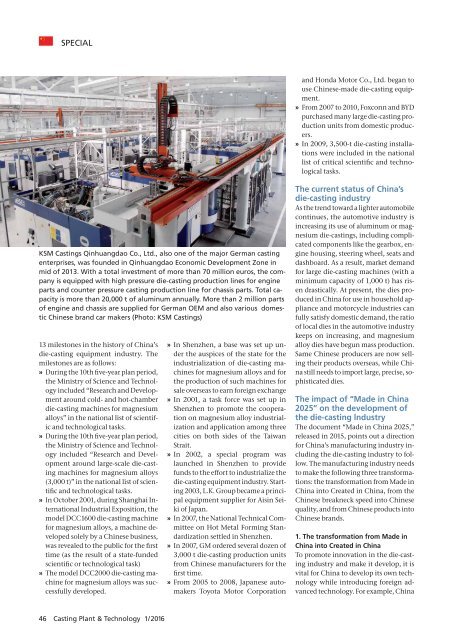CPT International 01/2016
The leading technical journal for the global foundry industry – Das führende Fachmagazin für die weltweite Gießerei-Industrie
The leading technical journal for the
global foundry industry – Das führende Fachmagazin für die
weltweite Gießerei-Industrie
Create successful ePaper yourself
Turn your PDF publications into a flip-book with our unique Google optimized e-Paper software.
SPECIAL<br />
and Honda Motor Co., Ltd. began to<br />
use Chinese-made die-casting equipment.<br />
» From 2007 to 2<strong>01</strong>0, Foxconn and BYD<br />
purchased many large die-casting production<br />
units from domestic producers.<br />
» In 2009, 3,500-t die-casting installations<br />
were included in the national<br />
list of critical scientific and technological<br />
tasks.<br />
KSM Castings Qinhuangdao Co., Ltd., also one of the major German casting<br />
enterprises, was founded in Qinhuangdao Economic Development Zone in<br />
mid of 2<strong>01</strong>3. With a total investment of more than 70 million euros, the company<br />
is equipped with high pressure die-casting production lines for engine<br />
parts and counter pressure casting production line for chassis parts. Total capacity<br />
is more than 20,000 t of aluminum annually. More than 2 million parts<br />
of engine and chassis are supplied for German OEM and also various domestic<br />
Chinese brand car makers (Photo: KSM Castings)<br />
13 milestones in the history of China’s<br />
die-casting equipment industry. The<br />
milestones are as follows:<br />
» During the 10th five-year plan period,<br />
the Ministry of Science and Technology<br />
included “Research and Development<br />
around cold- and hot-chamber<br />
die-casting machines for magnesium<br />
alloys” in the national list of scientific<br />
and technological tasks.<br />
» During the 10th five-year plan period,<br />
the Ministry of Science and Technology<br />
included “Research and Development<br />
around large-scale die-casting<br />
machines for magnesium alloys<br />
(3,000 t)” in the national list of scientific<br />
and technological tasks.<br />
» In October 20<strong>01</strong>, during Shanghai <strong>International</strong><br />
Industrial Exposition, the<br />
model DCC1600 die-casting machine<br />
for magnesium alloys, a machine developed<br />
solely by a Chinese business,<br />
was revealed to the public for the first<br />
time (as the result of a state-funded<br />
scientific or technological task)<br />
» The model DCC2000 die-casting machine<br />
for magnesium alloys was successfully<br />
developed.<br />
» In Shenzhen, a base was set up under<br />
the auspices of the state for the<br />
industrialization of die-casting machines<br />
for magnesium alloys and for<br />
the production of such machines for<br />
sale overseas to earn foreign exchange<br />
» In 20<strong>01</strong>, a task force was set up in<br />
Shenzhen to promote the cooperation<br />
on magnesium alloy industrialization<br />
and application among three<br />
cities on both sides of the Taiwan<br />
Strait.<br />
» In 2002, a special program was<br />
launched in Shenzhen to provide<br />
funds to the effort to industrialize the<br />
die-casting equipment industry. Starting<br />
2003, L.K. Group became a principal<br />
equipment supplier for Aisin Seiki<br />
of Japan.<br />
» In 2007, the National Technical Committee<br />
on Hot Metal Forming Standardization<br />
settled in Shenzhen.<br />
» In 2007, GM ordered several dozen of<br />
3,000 t die-casting production units<br />
from Chinese manufacturers for the<br />
first time.<br />
» From 2005 to 2008, Japanese automakers<br />
Toyota Motor Corporation<br />
The current status of China’s<br />
die-casting industry<br />
As the trend toward a lighter automobile<br />
continues, the automotive industry is<br />
increasing its use of aluminum or magnesium<br />
die-castings, including complicated<br />
components like the gearbox, engine<br />
housing, steering wheel, seats and<br />
dashboard. As a result, market demand<br />
for large die-casting machines (with a<br />
minimum capacity of 1,000 t) has risen<br />
drastically. At present, the dies produced<br />
in China for use in household appliance<br />
and motorcycle industries can<br />
fully satisfy domestic demand, the ratio<br />
of local dies in the automotive industry<br />
keeps on increasing, and magnesium<br />
alloy dies have begun mass production.<br />
Same Chinese producers are now selling<br />
their products overseas, while China<br />
still needs to import large, precise, sophisticated<br />
dies.<br />
The impact of “Made in China<br />
2025” on the development of<br />
the die-casting lndustry<br />
The document “Made in China 2025,”<br />
released in 2<strong>01</strong>5, points out a direction<br />
for China’s manufacturing industry including<br />
the die-casting industry to follow.<br />
The manufacturing industry needs<br />
to make the following three transformations:<br />
the transformation from Made in<br />
China into Created in China, from the<br />
Chinese breakneck speed into Chinese<br />
quality, and from Chinese products into<br />
Chinese brands.<br />
1. The transformation from Made in<br />
China into Created in China<br />
To promote innovation in the die-casting<br />
industry and make it develop, it is<br />
vital for China to develop its own technology<br />
while introducing foreign advanced<br />
technology. For example, China<br />
46 Casting Plant & Technology 1/2<strong>01</strong>6


















